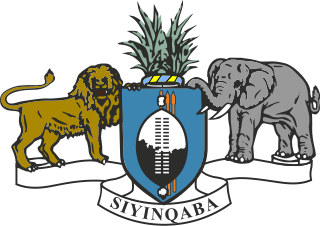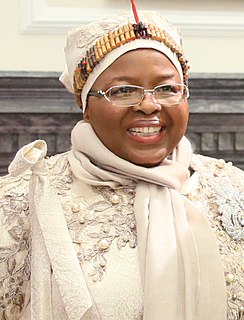
Eswatini is an absolute monarchy with constitutional provisions and Swazi law and Custom. The head of state is the king or Ngwenyama, currently King Mswati III, who ascended to the throne in 1986 after the death of his father King Sobhuza II in 1982 and a period of regency. According to the constitution of Eswatini, the king and Ingwenyama is a symbol of unity and the eternity of the Swazi nation. By tradition, the king reigns along with his mother or a ritual substitute, the Ndlovukati. The former was viewed as the administrative head of state and the latter as a spiritual and national head of state, with real power counterbalancing that of the king, but during the long reign of Sobhuza II the role of the Ndlovukati became more symbolic. The king appoints the prime minister from the legislature and also appoints a minority of legislators to both chambers of Libandla (parliament), with help from an advisory council. The king is allowed by the constitution to appoint some members to parliament for special interests. These special interests are citizens who might have been left out by the electorate during the course of elections or did not enter as candidates. This is done to balance views in parliament. Special interests could be people of gender, race, disability, business community, civic society, scholars, chiefs and so on. The Senate consists of 30 members, of which some are appointed by the king on recommendation of the advisory council and others elected by the lower house. The House of Assembly has 65 seats, 55 of which are occupied by elected representatives from the 55 constituencies around the country, 10 appointed by the king on recommendation of the advisory council and the attorney general is the ex-officio member. Elections are held every five years.

Artifacts indicating human activity dating back to the early Stone Age have been found in the Kingdom of Eswatini. Prehistoric rock art paintings date from c. 25,000 B.C. and continuing up to the 19th century can be found in various places around the country.

The Swazi or Swati are a Bantu ethnic group of Southern Africa, predominantly inhabiting modern Eswatini and South Africa's Mpumalanga province. The Swati are part of the Nguni family that can be archaeologically traced in East Africa where the same tradition, beliefs and cultural practices are found. The Swati share a unique experience, culture and Royal lineage. This lineage is exclusive to the inhabitants of Eswatini, even though there have been more Swazi people that have moved to South Africa and the United Kingdom in the 20th century. The original inhabitants of Eswatini no longer reside in Eswatini as a majority population while some remain in the land. The Swazi people and the Kingdom of Eswatini today are named after Mswati II, who became king in 1839 after the death of his father King Sobhuza who strategically defeated the British who occupied Swaziland. The Kingdom of Swaziland was a region occupied by the San people of Southern Africa and the current Swazis came in from North Eastern regions through to Mozambique and eventually Swaziland in the 15th century. Mixtures with the San people and other Nguni tribes occurred. Their royal lineage can be traced to a chief named Dlamini I; this is still the royal clan name. About three-quarters of the clan groups are Nguni; the remainder are Sotho, Tsonga, others North East African and San descendants. These groups have intermarried freely. There are slight differences among Swazis as a nation with varying features and skin tones yet Swazi identity extends to all those with allegiance to the twin monarchs Ingwenyama "the Lion" and Indlovukati "the She-Elephant". The dominant Swati language and culture are factors that unify Swazis as a nation since there is no other language spoken except for English.
Ngwane V was the King of Swaziland from 1895 until his death on 10 December 1899. Ngwane was born the son of Mbandzeni and his mother Labotsibeni Mdluli. He ascended to the throne after a short regency of Queen Mother Tibati Nkambule. He was only 16 years old when he became king. His royal capital was at Zombodze while the Queen Mother's residence was at Lobamba. Ngwane became the king after the Swaziland convention of 1894. This had led to the classification of Swaziland as a protected state of the South African Republic which was then led by President Paul Kruger. During this time Swaziland had a partial Dutch administration in parallel to Ngwane's administration. The Dutch or European for European interests and Ngwane as head and authority of the Swazi nation. An annual payment was made to Ngwane and Labotsibeni while they were in office from taxes collected and from contributions from concessionaires and taxes. Ngwane's rule was short. In 1899 the Anglo-Boer war began, and brought to an end the Dutch or Boer partial administration of Swaziland and hence gave way to independence. However Mahlokohla died on 10 December of that year while dancing incwala. This was hid from the nation until the ceremony was over. Ngwane was succeeded by his four-month-old son Nkhotfotjeni and his wife Lomawa Ndwandwe. His mother Labotsibeni who had been very influential during his reign continued as queen regent until Sobhuza was crowned in 1921. Ngwane's reign gave way to a stable territory surrounded by conflicting states. Today Mahlokohla is named for one of the main streets, Mahlokohla Street in Swaziland's capital Mbabane.
Mswati II, also known as Mswati and Mavuso III, was the king of Eswatini between 1840 and 1868. He was also the eponym of Eswatini. Mswati is considered to be one of the greatest fighting kings of Eswatini. Under his kingship, the territorial boundaries of Eswatini were greatly increased. Mswati was the son of Sobhuza I and Tsandzile Ndwandwe who after ruling as Queen Mother became Queen Regent after the death of her son. After the death of Sobhuza, Mswati inherited an area which extended as far as present day Barberton in the north and included the Nomahasha district in the Portuguese territory of Mozambique. Mswati’s military power, initially suppressed by infighting with his brothers Fokoti, Somcuba and Malambule, was increased in the late 1850s and thereafter. When Mswati's armies attacked organized forces of other Bantu tribes or nations, the goal was initially plunder in the form of cattle and captives, rather than incorporation into one political unit. During this period the arrival of Trekboers, in what would become the Transvaal republic, marked the first contact between Swazis and European settlers. Mswati greatly extended the boundaries of the Swazi territory beyond that of the present state with military outposts and royal villages outposts such as Mbhuleni, on the upper Komati River at the foot of the Mkongomo Mountains, south of Badplaas, Mekemeke which is east of the Mbayiyane Mountains, situated east of Mantibovu. The death of Mswati II in July 1868 ended the era of Swazi conquest, territorial expansion and resulted in unification of various people into one nation.

Queen Mother Ntfombi, Ndlovukati of Eswatini is the current Ndlovukati and joint head of state of Eswatini, serving since 1986. She was also regent of Eswatini from 1983 to 1986. She is the mother of King Mswati III.

Lobamba is the traditional, spiritual, and legislative capital city of Eswatini, seat of the Parliament, and residence of the Ntombi, the Queen Mother. Mswati III lives about 10 kilometres (6.2 mi) away at the Lozitha Palace. The King and Queen Mother participate in annual December and January Incwala ceremonies and August and September Reed Dancees at the Royal Kraal.
Inkhosikati LaShongwe was Queen Regent of Swaziland between 21 September 1982 and 9 August 1983. She was a wife of king Sobhuza II of Swaziland, and with him had one child, Prince Khuzulwandle Dlamini.
Mbandzeni (1855–1889) was the King of Swaziland from 1875 until 1889. Ingwenyama Mbandzeni was the son of Mswati II and Nandzi Nkambule. His mother the wife of King Mswati had died when he was still very young. Mbandzeni ascended to the throne after his half brother Ludvonga II died before he could become the king. Ludvonga's death resulted in his mother Inkhosikati Lamgangeni adopting Mbandzeni who was motherless as her son, thus making him King and her the Queen mother of Swaziland. His royal capital was at Mbekelweni. During his kingship Mbandzeni, granted many mining, farming, trading and administrative concessions to white settlers from Britain and the Transvaal. These concessions granted with the help of Offy Sherpstone eventually led to the conventions of 1884 and 1894, which reduced the overall borders of Swaziland and later made Swaziland a protectorate of the South African Republic. During a period of concessions preceded by famine around 1877 some of the tindvunas (governors) from within Swaziland like Mshiza Maseko and Ntengu kaGama Mbokane were given permission by King Mbandzeni to relocate to farms towards the Komati River, Mshiza Maseko later settled in a place called eLuvalweni, where he was later buried. Mbandzeni, still in command of a large Swazi army of more than 15000 men aided the British in defeating Sekhukhune in 1879 and preventing Zulu incursion into the Transvaal during the same year. As a result, he guaranteed his country's independence and international recognition despite the Scramble for Africa which was taking place at the time. Mbandzeni died after an illness in 1889 and is quoted to have said in his deathbed "the Swazi kingship dies with me". He was buried at the royal cemetery at Mbilaneni alongside his father and grandfather Sobhuza I. Mbandzeni was succeeded by his young son Mahlokohla and his wife Queen Labotsibeni Mdluli after a 5 year regency of Queen Tibati Nkambule. Today a number of buildings and roads in Swaziland are named after Mbandzeni. Among these the Mbandzeni house in Mbabane and the Mbandzeni Highway to Siteki are named after him.

The House of Dlamini is the royal house of the Kingdom of Eswatini. Mswati III, as king and Ngwenyama of Swaziland, is the current head of the house of Dlamini. Swazi kings up to the present day are referred to as Ingwenyama and they rule together with the Queen Mother who is called Indlovukati. The Swazi kings, like other Nguni nations, practice polygamy and thus have many wives and children.
Articles related to Eswatini include:
laNgolotsheni (Lomawa) Ndwandwe was the Ndlovukati of Swaziland, the wife of King Ngwane V, and the mother of King Sobhuza II.

Tsandzile Dlamini is a princess of Swaziland who currently serves as Minister of Home Affairs.












